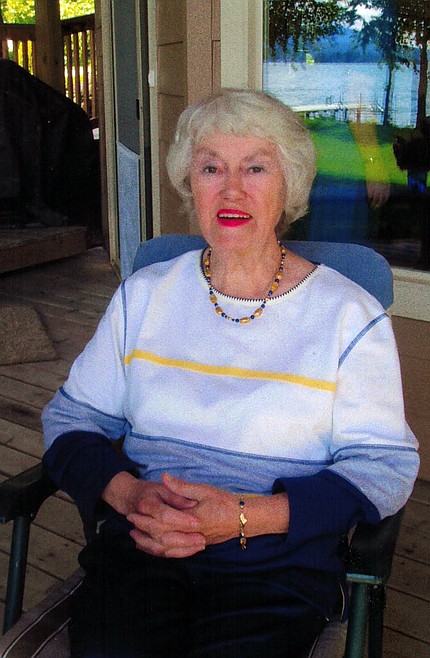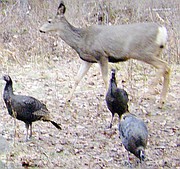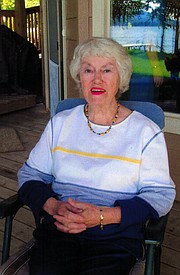Nature's visitors keep life enjoyable through smoke, COVID
I’ve been so enamored of touting summer’s fruits that I’ve left my bird, nature and garden reports whistling in the smoky wind. Today, I’ll try to get back on track and indeed, have plenty of “nature news” to share with you.
First, after all my comfortable years of a little ornithological knowledge, I recently got an amazing awakening via my last Audubon magazine. An article wryly pointing out the tendency to ignore the habits of female birds, announced studies showing that in many species of songbirds, mated pairs separated and migrated in male and female flocks to completely different sites.
We’ve all seen how the males leave earlier than the females and assumed that they would join up at their migratory areas. Now, it’s been observed that many species separate for the winter season — often at considerable distances - and rejoin at their customary “residences” in the spring. That’s why many males of various species arrive here prior to the females who will return later according to the weather.
Why would this happen? For very good reasons, we’re told: in the event of a weather catastrophe, which often decimates flocks of birds, a few males — or females — according to location, will survive to return “home” in the spring and find new mates to keep the flock strong.
In my area, the male towhees, grosbeaks, finches and such are long gone, and just recently the females have departed as well. All the chickadees, nuthatches, song sparrows and woodpecker family members have remained for the winter, as per usual. I was thrilled when one rare (in my location) Red Crossbill showed up briefly — adding only a third visit in all my years here. I’m enclosing a (canned) photo of one which doesn’t do justice to its brilliant red color.
It’s my joy and pleasure to keep plenty of black oil sunflower seeds on hand, broadcast and in protected hanging baskets to keep them supplied over winter. I’ve already hung out a couple of suet blocks, beloved of all the woodpecker clan, but surprisingly visited often by the nuthatches and chickadees as well. The adverse weather has cut down on the insect population and that may be the answer. The turkeys are always invited to partake of the seed feast, often accompanied by an opportunistic deer, as shown in the photo.
The moth and butterfly population was way down this season — doubtless due to the smoky, toxic air, but I was once again visited by the huge, gorgeous moth which surprisingly rested for three days on my door jamb exactly where another one did several years ago. Breathtaking, as you can see from my photo.
Anyone who has read “The Rhyme of the Ancient Mariner” recalls the tragedy following his killing of an albatross — and indeed, they are truly almost mystical in their seemingly never-ending oceanic flights that take up 90 percent of their time. However, another facet of their lives, recently discovered, provides an amazing testament to their longevity. On the atoll of Midway, where the Laysan Albatrosses nest and lay their single eggs, a longtime crew worker who counted nests, banded and sometimes re-banded the great birds, discovered that a particular female had first been banded in 1956 — probably when she was about 4 or 5 years old. In 1962 she received her second band — with others to follow, so that this year makes her at least 70 years old. Named “Wisdom”, she and her (supposedly) lifetime mate alternate egg/hatchling nest-sitting duties with food-gathering from the ocean. She’s become famous since her age has been discovered, with stories, books and toy birds created in her honor. I had to pass her story on because it’s so beautiful and we know so little about so much of our wonderful world.
Returning to the mundane world, I must give a thumbs-up and kudos to Paul Graves for his last “Geezer” column wherein he gently but firmly reproached the mind-set of the many area folks who still balk at wearing face-masks during this nasty COVID emergency. I too, can scarcely believe some of the attitudes and actions of people denying its reality or even treating it like a farce. I, who am blessed by being as healthy as a horse — with only a gimpy foot to slow me down — realize that I am as susceptible as anyone to the virus and could also unknowingly be a carrier, therefore on my weekly foray to the grocers, I am masked and gloved. I’ve had my shots and am grateful to have been spared thus far.
I have to add a funny personal note (confession) here: As you all know I was born in 1930 which made me an impressionable teenager during WWII. Those were the days of the great musicals and gorgeous movie stars — Betty Grable comes to mind — she of the beautiful legs and bright red lipstick. All the stars wore impeccable make-up and at age 15 (1945) as a junior in high school, I began wearing lipstick. I’ve NEVER stopped. At 91, I still wake up, wash face and hands, brush teeth and hair — and put on my lipstick. (I’m sure the turkeys appreciate it when I feed them at 6:30 a.m.). And at the weekly trek to the grocery store, mask firmly in place, I’m wearing lipstick underneath it.
Hang in there, everyone — we’ll get through all this together. See you next week. V.
Valle Novak writes the Country Chef and Weekend Gardener columns for the Daily Bee. She can be reached at bcdailybee@bonnercountydailybee.com. or by phone at 208-265-4688 between the hours of 8 a.m. to 7 p.m.







